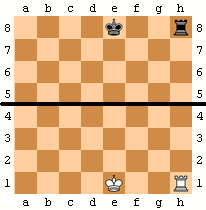Castling facts for kids
Castling is a super cool and special move in chess. It's the only time you can move two of your own pieces at once! This move involves your king and one of your rooks.
When you castle, your king moves two squares towards one of your rooks. Then, that rook jumps over the king and lands right next to it. You can castle on either side of the board. If you castle towards the king's starting side, it's called king-side castling (or castling short). If you castle towards the queen's starting side, it's called queen-side castling (or castling long).
When Can You Castle?
Castling is a powerful move, but you can only do it if certain rules are followed. Think of these as important checks before you make the move:
- No Moving Before! Neither your king nor the rook you want to use for castling can have moved at all during the game. If either piece has moved, even just one square and then back, you can't castle with them.
- King's Safety First! Your king must not be in check when you castle. Also, the squares your king moves through, or the square it lands on, cannot be attacked by your opponent's pieces. It's okay if the rook is being attacked, though!
- Clear Path! There must be no other chess pieces between your king and the rook you want to castle with. The path between them needs to be completely clear.
Why Castling is a Smart Move
Most good chess players use castling in nearly all their games. It's often a very smart idea for a few reasons:
- King Safety: Castling usually moves your king to a much safer spot on the board. The middle of the board can be dangerous for your king early in the game, as many pieces might attack it there. Castling helps tuck your king away behind a wall of pawns.
- Rook Power: This move also helps bring your rook into the game more quickly. After castling, your rook is often in a better position to join the attack or defend other pieces.
King-side castling is generally seen as a bit safer because the king ends up closer to the corner. Queen-side castling can sometimes be more aggressive, as the rook ends up closer to the center of the board.
See also
In Spanish: Enroque para niños



